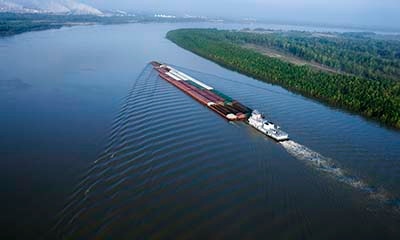
Growth in the volume of world trade is expected to remain sluggish in 2016 at 2.8%, unchanged from the 2.8% increase registered in 2015. Imports of developed countries should moderate this year while demand for imported goods in developing Asian economies should pick up. Global trade growth should rise to 3.6% in 2017, World Trade Organization (WTO) economists report.

Growth in the volume of world trade is expected to remain sluggish in 2016 at 2.8%, unchanged from the 2.8% increase registered in 2015. (Photo: Ron Chapple Stock/Thinkstock)
Risks to this forecast are mostly on the downside, including a sharper than expected slowing of the Chinese economy, worsening financial market volatility, and exposure of countries with large foreign debts to sharp exchange rate movements. On the other hand, there is some upside potential if monetary support from the European Central Bank succeeds in generating faster growth in the euro area.
“Trade is still registering positive growth, albeit at a disappointing rate,” WTO director-general Roberto Azevêdo says. “This will be the fifth consecutive year of trade growth below 3%. Moreover, while the volume of global trade is growing, its value has fallen because of shifting exchange rates and falls in commodity prices. This could undermine fragile economic growth in vulnerable developing countries. There remains as well the threat of creeping protectionism as many governments continue to apply trade restrictions and the stock of these barriers continues to grow.
“However, we should keep these figures in perspective,” he adds. “WTO Members can take a number of steps to use trade to lift global economic growth — from rolling back trade restrictive measures, to implementing the WTO Trade Facilitation Agreement. This Agreement will dramatically cut trade costs around the world, thereby potentially boosting trade by up to $1 trillion a year. More can also be done to address remaining tariff and non-tariff barriers on exports of agricultural and manufactured goods.”
On the basis of the forecast for 2016, world trade will have grown at roughly the same rate as world GDP for five years (at market exchange rates), rather than twice as fast as was previously the case. Such a long, uninterrupted spell of slow but positive trade growth is unprecedented, but its importance should not be exaggerated.
Overall, trade growth was weaker between 1980 and 1985, when five out of six years were below 3%, including two years of outright contraction.
Alternative indicators of economic and trade activity in the opening months of 2016 are mixed, with some pointing to a firming of trade and output growth while others suggest some slowing. On the positive side, container throughput at major ports has recovered much of the ground lost to the trade slowdown last year, while automobile sales — one of the best early signals of trade downturns — have continued to grow at a healthy pace in developed countries. On the other hand, composite leading indicators from the Organization for Economic Cooperation and Development point to an easing of growth in OECD countries, and financial market volatility has continued in 2016. Therefore trade growth may remain volatile in 2016.
Slowing trade in manufactured goods and agricultural products contributed significantly to the overall decline, the WTO said.
North America made a positive contribution to world import growth last year (1.1%), while negative contributions were recorded in 2015 for South and Central America (-0.2%) and Other regions, which covers Africa, the Middle East and CIS countries (-0.4%).
WTO growth forecast. -- >>>
~~~PAGE_BREAK_HERE~~~
Outlook
The WTO's forecast of 2.8% growth in the volume of world merchandise trade for 2016 and 3.6% trade growth for 2017 are based on consensus estimates of real GDP at market exchange rates from economic forecasters (Table 1). According to these estimates, world GDP should grow 2.4% this year and 2.7% next year, with growth slowing slightly in developed countries in 2016 and picking up modestly in developing ones.
Exports of developed and developing countries should grow at around the same rate in 2016, 2.9% in the former and 2.8% in the latter. Meanwhile, imports of developed economies are expected to outpace those of developing countries in 2016, with a 3.3% rise in the former compared to a 1.8% increase in the latter.
Asia is expected to record the fastest export growth of any region this year at 3.4%, followed by North America and Europe, each at 3.1%. South and Central America and Other regions will lag behind at 1.9% and 0.4%, respectively. North America should see its imports increase by 4.1% this year, while Asian and European imports should both register growth of 3.2%. Finally, imports of South and Central America and Other regions are set to contract again this year as oil and other commodity prices remain low, but the degree of contraction should be less.
Risks to the trade forecasts remain tilted to the downside. Business and consumer confidence has slipped recently in developed countries. As a result, forecasters now expect slower GDP growth in the European Union and the United States in 2016, followed by a rebound in 2017. Financial instability in Asia has mostly abated but could return if economic data come in above or below market expectations. On the other hand, more accommodative monetary policy from the European Central Bank could spur growth in the euro area and boost demand for goods and services, including imports.
About the Author(s)
You May Also Like






